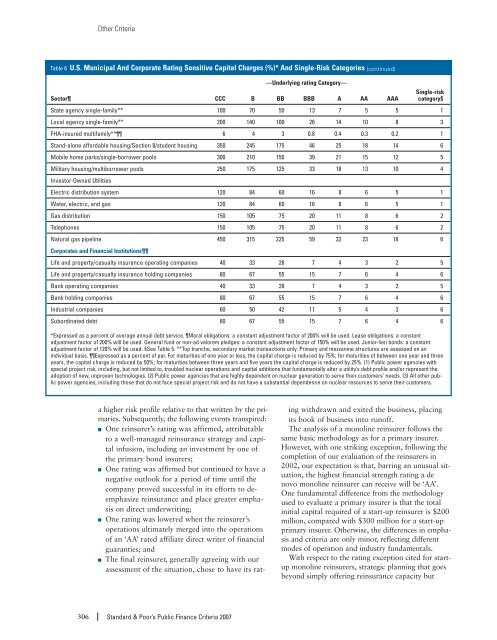S&P - Public Finance Criteria (2007). - The Global Clearinghouse
S&P - Public Finance Criteria (2007). - The Global Clearinghouse
S&P - Public Finance Criteria (2007). - The Global Clearinghouse
Create successful ePaper yourself
Turn your PDF publications into a flip-book with our unique Google optimized e-Paper software.
Other <strong>Criteria</strong>Table 6 U.S. Municipal And Corporate Rating Sensitive Capital Charges (%)* And Single-Risk Categories (continued)—Underlying rating Category—Single-riskSector CCC B BB BBB A AA AAA category§State agency single-family** 100 70 50 13 7 5 5 1Local agency single-family** 200 140 100 26 14 10 8 3FHA-insured multifamily** 6 4 3 0.8 0.4 0.3 0.2 1Stand-alone affordable housing/Section 8/student housing 350 245 175 46 25 18 14 6Mobile home parks/single-borrower pools 300 210 150 39 21 15 12 5Military housing/multiborrower pools 250 175 125 33 18 13 10 4Investor-Owned UtilitiesElectric distribution system 120 84 60 16 8 6 5 1Water, electric, and gas 120 84 60 16 8 6 5 1Gas distribution 150 105 75 20 11 8 6 2Telephones 150 105 75 20 11 8 6 2Natural gas pipeline 450 315 225 59 32 23 18 6Corporates and Financial InstitutionsLife and property/casualty insurance operating companies 40 33 28 7 4 3 2 5Life and property/casualty insurance holding companies 80 67 55 15 7 6 4 6Bank operating companies 40 33 28 7 4 3 2 5Bank holding companies 80 67 55 15 7 6 4 6Industrial companies 60 50 42 11 5 4 3 6Subordinated debt 80 67 55 15 7 6 4 6*Expressed as a percent of average annual debt service. Moral obligations: a constant adjustment factor of 200% will be used. Lease obligations: a constantadjustment factor of 200% will be used. General fund or non-ad valorem pledges: a constant adjustment factor of 150% will be used. Junior-lien bonds: a constantadjustment factor of 120% will be used. §See Table 5. **Top tranche, secondary market transactions only. Primary and mezzanine structures are assessed on anindividual basis. Expressed as a percent of par. For maturities of one year or less, the capital charge is reduced by 75%; for maturities of between one year and threeyears, the capital charge is reduced by 50%; for maturities between three years and five years the capital charge is reduced by 25%. (1) <strong>Public</strong> power agencies withspecial project risk, including, but not limited to, troubled nuclear operations and capital additions that fundamentally alter a utility’s debt profile and/or represent theadoption of new, unproven technologies. (2) <strong>Public</strong> power agencies that are highly dependent on nuclear generation to serve their customers’ needs. (3) All other publicpower agencies, including those that do not face special project risk and do not have a substantial dependence on nuclear resources to serve their customers.a higher risk profile relative to that written by the primaries.Subsequently, the following events transpired:■ One reinsurer’s rating was affirmed, attributableto a well-managed reinsurance strategy and capitalinfusion, including an investment by one ofthe primary bond insurers;■ One rating was affirmed but continued to have anegative outlook for a period of time until thecompany proved successful in its efforts to deemphasizereinsurance and place greater emphasison direct underwriting;■ One rating was lowered when the reinsurer’soperations ultimately merged into the operationsof an ‘AA’ rated affiliate direct writer of financialguaranties; and■ <strong>The</strong> final reinsurer, generally agreeing with ourassessment of the situation, chose to have its ratingwithdrawn and exited the business, placingits book of business into runoff.<strong>The</strong> analysis of a monoline reinsurer follows thesame basic methodology as for a primary insurer.However, with one striking exception, following thecompletion of our evaluation of the reinsurers in2002, our expectation is that, barring an unusual situation,the highest financial strength rating a denovo monoline reinsurer can receive will be ‘AA’.One fundamental difference from the methodologyused to evaluate a primary insurer is that the totalinitial capital required of a start-up reinsurer is $200million, compared with $300 million for a start-upprimary insurer. Otherwise, the differences in emphasisand criteria are only minor, reflecting differentmodes of operation and industry fundamentals.With respect to the rating exception cited for startupmonoline reinsurers, strategic planning that goesbeyond simply offering reinsurance capacity but306 Standard & Poor’s <strong>Public</strong> <strong>Finance</strong> <strong>Criteria</strong> <strong>2007</strong>
















